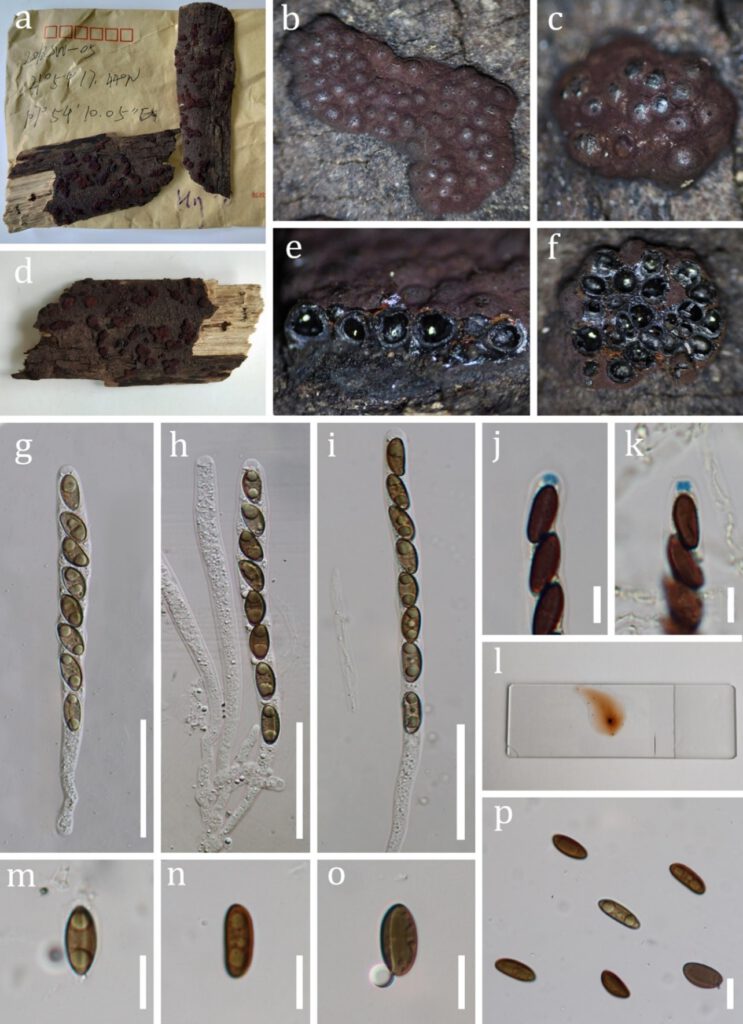Hypoxylon guangxiensis Appad., Li and K.D. Hyde,
Mycobank number: MB 840203; Index Fungorum number: IF 840203; Facesoffungi number: FoF 10831;
Saprobic on corticated branch of unknown plant. Sexual morph: Ascostromata 0.5–3 mm × 0.3–1.5 mm (n = 30), superficial, sphaerical, hemisphaerical, effused-pulvinate, with perithecial contours exposed, carbonaceous, surface violet brown, persian orange to reddish orange granules beneath the surface and between the perithecia; with KOH extractable brownish orange pigments, black sub-perithecial tissue. Perithecia 0.36–0.52 mm × 0.45–0.68 mm (n =30) pyriform to spherical, immersed. Ostioles conical papillate, lower than the stromatal surface. Asci 117–164 μm × 8–12 μm (x̅ = 139 × 10 μm, n =20), unitunicate, 8-spored, uniseriate, obliquely arranged, cylindrical, long stipitate, with apical apparatus bluing in Melzer’s reagent, 1.1–2.1 μm × 2.3–3.3 μm (n =16), discoid, wedge-shaped. Ascospores 11–15 × 4.7–7.4 μm (x̅ = 13 × 6.0 μm, n =50), olive brown to dark brown, unicellular, ellipsoid to inequilateral, narrow to broadly rounded ends with straight conspicuous germ slit spore–length, epispore smooth, perispore indehiscent in 10% KOH. Asexual morph: Undetermined.
Material examined – CHINA. Guangxi Province, Fangchenggang City, Shangsi County, Shiwandashan National Nature Reserve, (107º54’10.05″E 4º59’17.44″N), on dead trunk, 13 July 2018, Q.R. Li, GMB0217 (holotype), GMBC0217 (Ex-type cultures); ibid., Q.R. Li, 2018SW052
Distribution – China
Sequence data – ITS: MZ746138.1
Notes – Hypoxylon guangxiensis is morphologically similar to H. hinnuleum, H. investiens, H. lateripigmentum, H. pulicicidum and H. olivaceopigmentum with respect to their effused vinaceous to brown vinaceous stromata, ascospore size range (7–12 × 3–6.6 μm) and straight germ slit. Based on the phylogenetic analyses, our new isolate clusters with these five species with high bootstrap and posterior probability support (MLBS>99%, and BYPP 1). Hypoxylon guangxiensis is distinguished from its closely related species (TABLE 3) by having brownish orange KOH extractable pigments, longer asci, longer and larger apical ring and slightly larger ascospores (11–15 × 4.7–7.4 μm). The species closest to ours in the phylogenetic analyses, H. lateripigmentum, displays several morphological similarities to H. guangxiensis, with brownish orange (Sienna) pigments in KOH. However, the pigments of H. lateripigmentum pigments turn bay to dark isabelline upon prolonged incubation, whilez H. guangxiensis remain brownish orange. Hypoxylon guangxiensis also differs from H. lateripigmentum in having smaller stromata (8–18mm × 4–6mm vs 5–90 mm × 3–16 mm × 0.9–1.1 mm), Persian orange to reddish orange pigments instead of olivaceous yellow granules beneath the surface and between the perithecia, larger asci (117–164 μm × 8–12 μm vs 85–155 μm), larger apical apparatus (1.1–2.1 μm × 2.3–3.3 μm vs 1–1.2 × 2–2.5 μm), larger ascospores (11–15 × 4.7–7.4 μm vs 7.7–9.5 × 3.8–4.2 μm) and indehiscent (vs dehiscent) perispore in 10% KOH (TABLE 3). The phylogenetic analyses also support our morphological observations and justify the erection as new species of Hypoxylon.

FIGURE 1. Hypoxylon guangxiensis (holotype) a Host. b Stromatal habit on host. b-c Stromata surface. e Cross section of the stroma showing the perithecia, subsurface granules and the subperithecial tissue. f Perithecia from above. g-i Asci j-k Ascal apical apparatus in Melzer’s reagent. l KOH- extractable pigments m-p Ascopores, m and o Ascospore with germ slit
